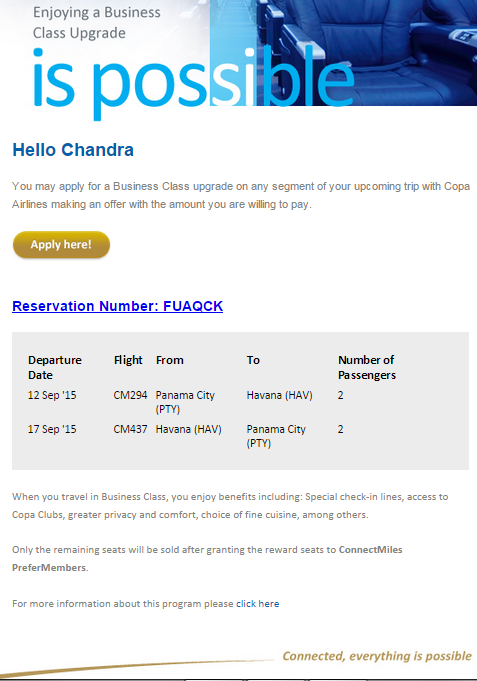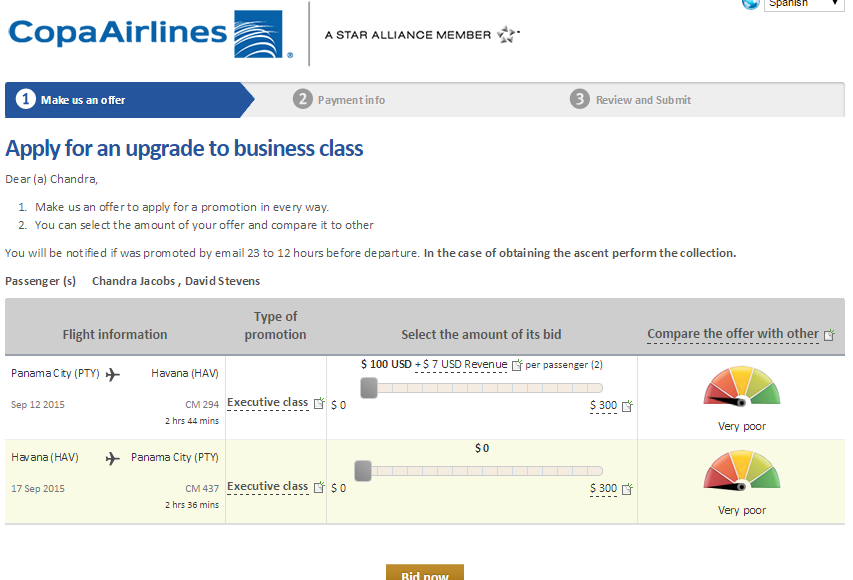I flew Copa Airlines for the first time last month to Panama City and Cuba, and got to experience the Copa Airlines branded fares upsell marketing tactics first-hand. It made such an impression on me that I saved the screenshots of the process, and filed it away to write a blog on it later.
That day has finally come. But before I get in to the specifics of the innovative Copa Airlines branded fares upsell strategy, let me first explain to you the meaning of a “branded fare.”
They are a bundle of a base fare and accompanying ancillaries that the airline sells under a specific brand and as a packaged unit.
For example, a carrier may have a brand name for their business class offering, a different brand name for its economy offering, and even yet a different brand name for it’s Premium economy offering.
Take Delta Comfort for example – it includes a premium economy seat with extra legroom, Sky Priority® Boarding, dedicated overhead space, snacks, free drinks, and complimentary entertainment. This is an example of a branded fare. Most of the time the bundle of items included in the branded fare are a better value than summing up the cost of the individual items.
Each brand can be associated with one Fare Family or multiple Fare Families. A Fare Family can be defined by routes or travel dates. If a carrier has only one global market, then the carrier probably has only one Fare Family with several Brands inside that Family. So because of that, not all branded fares are available on all aircraft and routes.
There’s also a concept called ancillaries. Ancillaries are additional items that can be added in or upsold to the fare or branded fare offered by an airline. For example, you can buy the Delta Comfort branded fare I described above, and then add in a paid, checked bag for an additional fee. Examples of ancillaries can be priority boarding, an assigned seat, a paid bag, or really anything that isn’t included in the branded fare itself.
Now that I’ve explained what a branded fare is, let me share with you the Copa Airlines branded fare upsell strategy, which they used after I had already purchased the ticket, but a few days before my flight was scheduled to depart.
Copa Airlines captured my email address at time of ticket purchase so they could cleverly market to me after the fact, and encourage me to buy a more expensive branded fare option prior to even getting to the airport. A few days before my flight, the airline sent me an email letting me know that an upgrade to business class was still possible.

Copa employed two marketing tactics in this case:
- Urgency – the Copa Airlines branded fare upsell email implied that time was running out.
- Value – The Copa Airlines branded fare upsell email also implied that this upgrade could be obtained either free, or at a discount, simply by clicking and following the instructions.
When I clicked the “Apply now” button (which implied that all I had to do was get on a waiting list of sorts and the upgrade I would be automatically notified of an upgrade), it took me to a Copa Airlines landing page with further upgrade instructions.

Copa Airlines decided to implement this branded fares upsell through a Priceline style bidding approach. Each row represents the flight that is eligible for me to upgrade, while the middle block shows the amount I am able to bid. Notice Copa Airlines decided to set a bidding floor ($100), which tells me that’s where its margin disappears and everything above $100 is profit. Therefore if I bid $200 (which may or may not actually have been cheaper than buying executive class in the first place), I can assume that Copa would make a $100 profit.
Finally, there’s a meter on the right side of each row that indicates how likely I am to obtain the branded fare for the price I’ve bid. At the floor of $100, the likelihood was very low. Also at $100, the likelihood that I would actually bid completely evaporated, and at this point I realized that the Copa Airlines branded fares upselll upgrade wasn’t “free” after all (it was only a 2 hour flight after all).
While I think Copa Airlines is clearly on to something with this approach, I think there is still room for improvement. Here are some suggestions I would made (feel free to leave your own in the “Comments” area below this blog):
- Let market forces prevail. I do not now whether this meter is arbitrary, or actually dynamic, nor do I know whether am I competing against other bidders, or just “competing” against a predetermined “buy” threshold that Copa Airlines has set. In other words, does the floor price fluctuate with actual inventory available (supply and demand)? Tying it to market forces would ensure that Copa Airlines doesn’t have a free seat in their higher cabin classes on every flight. In this situation, it would allow for an upgrade price of $0.
- Focus on last-minute upgrades. Taking the market forces argument to its natural conclusion, depending on how many higher branded fares exist on a flight, Copa could send an email just prior to the flight with an actual dollar amount that the passenger could upgrade for (with some “as low as”).
- True willingness to pay (WTP). If Copa’s willingness to sell is at or lower than the customer’s WTP, Copa should sell the upgrade. This relationship should be dynamic based on a number of factors including time to flight, value of the customer to Copa, potential recapture of an economy seat with an upgrade offer, and excess inventory to name a few.
- Clearer instructions and transparency. I’m not sure if my upgrade will “clear” right away, or if I have to wait to see what everyone else has bid within some time window (that isn’t explained). I’d also like to understand more about the algorithm used to get a sense of whether it seems “fair” or not.
All in all, an interesting idea from Copa Airlines and one I’ve never seen before in the industry. That said, it seemed a little forced and clearly was version 1.0 of the idea, being quite rough around the edges. I’m looking forward to see how this concept evolves in the industry, and whether other airlines decide to pick it up.